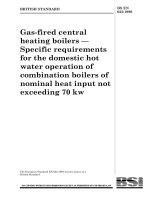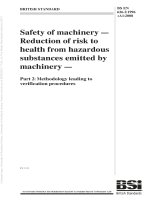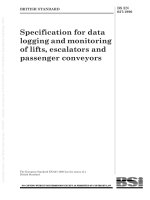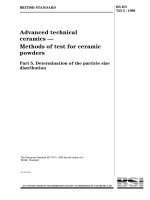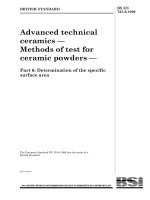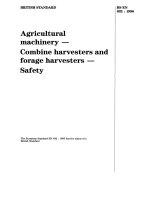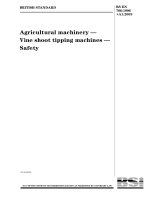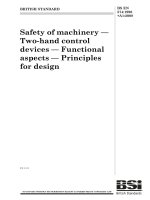Bsi bs en 61358 1996
Bạn đang xem bản rút gọn của tài liệu. Xem và tải ngay bản đầy đủ của tài liệu tại đây (995.21 KB, 32 trang )
BRITISH STANDARD
Acceptance inspection
for direct connected
alternating current
static watt-hour meters
for active energy
(classes 1 and 2)
The European Standard EN 61358:1996 has the status of a
British Standard
ICS 17.220.20
BS EN
61358:1996
IEC 1358:1996
BS EN 61358:1996
Committees responsible for this
British Standard
The preparation of this British Standard was entrusted to Technical
Committee PEL/13, Electricity meters, upon which the following bodies were
represented:
Building Automation and Mains Signalling Association (BAMSA)
BEAMA Metering Association (BMA)
Department of Trade and Industry
Electricity Association
Electricity Pool of England and Wales
Energy Systems Trade Association
Flag Association
Institution of Electrical Engineers
Office of Electricity Regulations (OFFER)
United Kingdom Automatic Meter Reading Association
This British Standard, having
been prepared under the
direction of the Electrotechnical
Sector Board, was published
under the authority of the
Standards Board and comes
into effect on
15 December 1996
© BSI 11-1998
The following BSI references
relate to the work on this
standard:
Committee reference PEL/13
Draft for comment 96/207919 DC
ISBN 0 580 26322 3
Amendments issued since publication
Amd. No.
Date
Comments
BS EN 61358:1996
Contents
Committees responsible
National foreword
Page
Inside front cover
ii
Foreword
Text on EN 61358:1996
2
3
List of references
© BSI 11-1998
Inside back cover
i
BS EN 61358:1996
National foreword
This British Standard has been prepared by Technical Committee PEL/13 and is
the English Language version of EN 61358:1996 Acceptance inspection for direct
connected alternating current static watt-hour meters for active energy (classes 1
and 2) published by the European Committee for Electrotechnical
Standardization (CENELEC). It is identical with IEC 1368:1996 published by
International Electrotechnical Commission (IEC).
Cross-references
Publication referred to
Corresponding British Standard
EN 60514:1995
(IEC 514:1975)
BS EN 60514 Acceptance inspection of class 2
alternating-current watt-hour meters
EN 61036:1992
(IEC:1990)
BS EN 61036:1993 Alternating current static
watt-hour meters for active energy (classes 1 and 2)
BS ISO 3534: Statistics. Vocabulary and symbols
ISO 3534-1:1993
BS ISO 3534-1:1993 Probability and general statistical
terms
ISO 3534-2:1993
BS ISO 3534-2:1993 Statistical quality control
A British Standard does not purport to include all the necessary provisions of a
contract. Users of British Standards are responsible for their correct application.
Compliance with a British Standard does not of itself confer immunity
from legal obligations.
Summary of pages
This document comprises a front cover, an inside front cover, pages i and ii,
the EN title page, pages 2 to 26, an inside back cover and a back cover.
This standard has been updated (see copyright date) and may have had
amendments incorporated. This will be indicated in the amendment table on
the inside front cover.
ii
© BSI 11-1998
EUROPEAN STANDARD
EN 61358
NORME EUROPÉENNE
EUROPÄISCHE NORM
June 1996
ICS 17.220.20
Descriptors: Acceptance inspection, static meter, active energy, direct connected, alternating current
English version
Acceptance inspection for direct connected alternating
current static watt-hour meters for active energy
(classes 1 and 2)
(IEC 1358:1996)
Contrôle de réception des compteurs statiques
d’énergie active pour courant alternatif et à
branchement direct (classes 1 et 2)
(CEI 1358:1996)
Annahmeprüfung von elektronischen
Wechselstrom-Wirkverbrauchzählern für
direkten Anschluß (Klassen 1 und 2)
(IEC 1358:1996)
This European Standard was approved by CENELEC on 1996-03-05.
CENELEC members are bound to comply with the CEN/CENELEC Internal
Regulations which stipulate the conditions for giving this European Standard
the status of a national standard without any alteration.
Up-to-date lists and bibliographical references concerning such national
standards may be obtained on application to the Central Secretariat or to any
CENELEC member.
This European Standard exists in three official versions (English, French,
German). A version in any other language made by translation under the
responsibility of a CENELEC member into its own language and notified to the
Central Secretariat has the same status as the official versions.
CENELEC members are the national electrotechnical committees of Austria,
Belgium, Denmark, Finland, France, Germany, Greece, Iceland, Ireland, Italy,
Luxembourg, Netherlands, Norway, Portugal, Spain, Sweden, Switzerland and
United Kingdom.
CENELEC
European Committee for Electrotechnical Standardization
Comité Européen de Normalisation Electrotechnique
Europäisches Komitee für Elektrotechnische Normung
Central Secretariat: rue de Stassart 35, B-1050 Brussels
© 1996 Copyright reserved to CENELEC members
Ref. No. EN 61358:1996 E
EN 61358:1996
Foreword
Page
The text of document 13/1093/FDIS, future edition 1
of IEC 1358, prepared by IEC TC 13, Equipment for
electrical energy measurement and load control,
was submitted to the IEC-CENELEC parallel vote
and was approved by CENELEC as EN 61358
on 1996-03-05.
The following dates were fixed:
—
—
latest date by which the
EN has to be
implemented at national
level by publication of an
identical national
standard or by
endorsement
latest date by which the
national standards
conflicting with the EN
have to be withdrawn
(dop) 1997-01-01
(dow) 1997-01-01
Annexes designated “normative” are part of the
body of the standard.
Annexes designated “informative” are given for
information only.
In this standard, annexes A and ZA are normative
and annex B is informative.
Annex ZA has been added by CENELEC.
Contents
Introduction
1
Scope
2
General remarks
3
Normative references
4
Definitions
5
Acceptance conditions for batches
6
Place of inspection
7
Test conditions
8
Inspection and test procedure
9
Requirements corresponding to
different inspection procedures
Annexe A (normative) Symbols
Annexe B (informative) Bibliography
Annexe ZA (normative) Normative
references to international publications
with their corresponding European
publications
2
Page
3
3
3
4
4
5
5
5
6
Figure 1 — Diagram of the single
sampling plan
Figure 2 — Diagram of the double
sampling plan
Figure 3 — Acceptance trapezium
(standard deviation method)
Figure 4 — Acceptance trapezium
(average range method)
Table 1 — Reference conditions
Table 2 — Uncertainty of measurement
Table 3 — AC voltage tests
Table 4 — Starting current
Table 5 — Test points and limits of errors
Table 6 — Acceptance number c
Table 7 — Example of using random
numbers
Table 8 — Sample plans
Table 9 — Double sampling plan
Table 10 — Specified values for the
standard deviation method
Table 11 — Specified values for the
average range method
Table 12a — Operating characteristic
curves N # 100
Table 12b — Operating characteristic
curves 101 # N # 500
Table 12c — Operating characteristic
curves 501 # N # 1 000
Table 13a — Acceptance trapezium,
T = 3,5 %
Table 13b — Acceptance trapezium,
T = 3,0 %
Table 13c — Acceptance trapezium,
T = 2,5 %
Table 14 — Inspection sheet
Table 15 — Random numbers
11
12
13
14
6
6
7
7
8
8
9
10
12
13
14
15
16
17
18
19
20
21
22
8
23
24
25
© BSI 11-1998
EN 61358:1996
Introduction
This International Standard describes, in some
detail, methods for acceptance inspection, and
testing of newly manufactured static watt-hour
meters delivered in quantities of 50 and above.
IEC 514 serves as a reference document and
annex A of that standard should be consulted for
explanatory notes concerning sampling procedures.
In this standard, wider error limits than those for
type tests specified in the relevant publications have
been allowed because:
— acceptance testing conditions have wider
tolerances than those for type tests;
— displacing of the zero axis is not applicable for
acceptance testing;
— the effects of handling of meters are taken into
account.
1 Scope
The methods and procedures included in this
International Standard apply to newly
manufactured direct connected alternating current
static watt-hour meters of classes 1 and 2, covered
by IEC 1036, which are produced and delivered in
quantities of 50 and above.
They provide for 100 % inspection or sampling
inspection for acceptance by the purchaser.
2 General remarks
2.1 Two methods of acceptance inspection are
proposed, namely:
— 100 % inspection, and
— sampling inspection.
2.2 The 100 % inspection consists of testing all the
meters of a batch.
2.3 The sampling inspection is based upon the
principles of mathematical statistics and as a
consequence certain specified risks are undertaken
both by the manufacturer and the purchaser.
However, sampling inspection generally is more
economical than 100 % inspection.
In this standard, sampling inspection has been
planned so that, in practice, the quality of the meter
batches can be judged with nearly the same
confidence as with 100 % inspection.
2.4 Two methods of sampling inspection are
described:
— inspection by attributes;
— inspection by variables.
1)
These two methods have been chosen so that the
judgement of quality is virtually the same for both
methods.
2.5 Inspection by attributes gives results indicating
conformity or non-conformity.
It shall be applied when the characteristics under
inspection cannot be measured.
It shall also be applied when a characteristic can be
measured but the values are not of normal
distribution (Laplace-Gauss).
It may be applied, when the distribution is
approximately normal, in place of inspection by
variables.
The advantage of inspection by attributes is its
simplicity of application.
2.6 Inspection by variables gives additional
information but it is applicable only when the values
of a characteristic are measurable and when those
values are approximately normally distributed. In
these circumstances, inspection by variables is the
recommended method.
The advantage of inspection by variables is a
smaller sample size than by attributes for the same
risk of decision. However, it requires more
calculation.
The test results are represented by:
x
= sample mean as an estimation of the
batch mean;
s
= standard
deviation
w = average
range
ỹ
ù
ý
ù
ỵ
as an estimation of the
dispersion of the
characteristics x in the
batch.
NOTE The average range is easier to calculate than the
standard deviation. However, when suitable calculating means
are available for making a decision and for preparing additional
information, the use of the standard deviation enables the
efficiency of the method to be increased for the same sample size.
2.7 Inspection by variables is based on normally
distributed values. It is recommended to test
whether the sample is normally distributed,
using e.g.:
— The “w/s” test of David, Hartley and Pearson.
For details of the test procedures see [1]1)
For this test only the figures w(xmax – xmin) and s
are needed.
— The Wilk-Shapiro test.
For details of the test procedures see [2].
— The Pearson chi-square test.
Figures in square brackets refer to the bibliography given in annex B.
© BSI 11-1998
3
EN 61358:1996
3 Normative references
The following normative documents contain
provisions which, through reference in this text,
constitute provisions of this International Standard.
At the time of publication, the editions indicated
were valid. All normative documents are subject to
revision, and parties to agreements based on this
International Standard are encouraged to
investigate the possibility of applying the most
recent editions of the normative documents
indicated below. Members of IEC and ISO maintain
registers of currently valid International Standards.
IEC 410:1973, Sampling plans and procedures for
inspection by attributes.
IEC 514:1975, Acceptance inspection of Class 2
alternating-current watthour meters.
IEC 1036:1990, Alternating current static watt-hour
meters for active energy (classes 1 and 2).
ISO 3534-1:1993, Statistics — Vocabulary and
symbols — Part 1: Probability and general
statistical terms.
ISO 3534-2:1993, Statistics — Vocabulary and
symbols — Part 2: Statistical quality control.
4 Definitions
For the purpose of this International Standard, the
following definitions apply.
For definitions concerning meters, reference is
made to IEC 1036. The majority of the definitions of
sampling techniques are generally in accordance
with [3] and with ISO 3534-1 and ISO 3534-2.
4.1
batch
definite quantity of meters of the same type, of the
same voltage and current rating and the same
register, delivered by one supplier, manufactured or
produced under conditions which are presumed
uniform
4.6
sampling inspection
inspection of a limited number of meters, taken at
random from the batch, according to a prescribed
sampling plan [ISO, modified]
4.7
sampling plan
plan according to which one or more samples are
taken to obtain information and possibly to reach a
decision [ISO, modified]
4.8
characteristic (quality characteristic)
property (e.g. dielectric strength, starting, accuracy
at one test point) of a meter which contributes to the
quality and which helps to differentiate between the
meters of a given batch. The differentiation may be
either quantitative (by variable) or qualitative (by
attributes)
if it is measurable, its value for a given meter i is
indicated by xi. [ISO, modified]
4.9
defect
failure of a meter to meet a standard with respect to
a characteristic [ISO] modified]
4.10
defective meter
meter having one or more defects [ISO, modified]
4.11
operating characteristic curve
curve showing, for a given sampling plan, the
probability of acceptance of a batch as a function of
its actual quality for a given characteristic
[ISO, modified]
4.12
inspection by attributes
number N of meters in a batch [ISO]
inspection whereby certain characteristics of the
sample meters are evaluated, classified as
conforming or not conforming to the requirements,
the number of defective meters counted and used as
the basis for judgement of the batch (EOQC)
4.3
sample
4.13
acceptance number
meters taken at random for inspection from a batch
maximum permitted number of defects in a sample
for inspection by attributes
4.2
batch size
4.4
sample size
number n of meters in the sample [ISO]
4.5
100 % inspection
inspection of every meter in a batch
4
4.14
inspection by variables
inspection whereby certain characteristics of the
sample meters (e.g. a meter error for a particular
current) are measured with respect to a continuous
scale (e.g. in per cent), and their mean value, the
standard deviation or the average range calculated
and used as the basis for judgement of the batch
© BSI 11-1998
EN 61358:1996
4.15
sample mean
x
arithmetic mean of values xi for a characteristic
(e.g. a meter error for a particular current) in the
sample:
4.20
acceptable quality level (AQL)
for given characteristic, maximum percentage of
defective meters in a batch that, for the purpose of
sampling inspection, can be considered
satisfactory (EOQC)
5 Acceptance conditions for batches
4.16
range wj
difference between the maximum and minimum
observed values of a given characteristic in a
subgroup:
A batch is deemed to comply with the requirements
of this standard and shall be accepted if for each
inspected characteristic the proportion of defective
meters does not exceed the following specified
values.
5.1 100 % inspection
The tests shall be made according to clause 8.
The number of meters failing the test shall not
exceed the acceptance number given in Table 6.
5.2 Sampling inspection
for subgroup j
NOTE For the purpose of this standard, the size m of a
subgroup j is 5 and there are r subgroups in a sample.
4.17
average range w
arithmetic mean of the r ranges wj of the r
subgroups in a sample
In the case of sampling inspection, the above
conditions shall be considered satisfied when for
each characteristic of the meters in the batch:
— for inspection by attributes, the number of
defective meters in the sample is smaller than or
equal to the acceptance number given in Table 8;
— for inspection by variables, the graphically
presented test result is within the acceptance
trapezium or the calculated test result does not
exceed the specified limits (see 9.2.3).
NOTE The risk of a wrong interpretation of the results can
be read off from the operating characteristic curves of
Table 12a, Table 12b and Table 12c.
NOTE This is an estimation of the dispersion of the
characteristic x in a batch.
4.18
standard deviation of the sample
NOTE This is an estimation of the dispersion of the
characteristic x in a batch.
4.19
acceptance trapezium
graph, with control limits, on which are plotted two
corresponding statistical values (i.e. sample mean x
and either standard deviation s or average
range w ), for each sample
© BSI 11-1998
6 Place of inspection
The inspection shall be carried out by mutual
agreement:
— on the manufacturer’s premises, but on test
benches other than those on which the
adjustments were made;
— or on the purchaser’s test benches;
— or on other agreed test benches.
7 Test conditions
7.1 Reference conditions
Tests shall be carried out under conditions given in
Table 1.
5
EN 61358:1996
Table 1 — Reference conditions
Influence quantity
Reference value
Permissible tolerances
Ambient temperature
Reference temperature or, in its
absence, 23 °C
± 2 °C
Voltage
Reference voltage
± 1,5 %
Frequency
Reference frequency
± 0,5 %
Waveform
Sinusoidal voltages and currents
Distortion factor less than 5 %
Magnetic induction of external
origin at the reference frequency
Magnetic induction equal to zero
Induction value which causes a
variation of error not greater than
± 0,3 % but should in any case be
smaller than 0,05 mTb
a
a For
any ambient temperature outside the range 21 °C to 25 °C, but within the range 15 °C to 30 °C, it is permissible to apply a
correction for the reference temperature of 23 °C, using the mean temperature coefficient of the meter type as declared by the
manufacturer.
b
The test consists of:
a) for a single-phase meter, determining the errors first with the meter normally connected to the mains and then after inverting
the connections to the current circuits as well as to the voltage circuits. Half of the difference between the two errors is the value
of the variation of error. Because of the unknown phase of the external field, the test should be made at 0,1 lb at unity power
factor and 0,2 lb at 0,5 power factor;
b) for a three-phase meter, making three measurements at 0,1 lb at unity power factor, after each of which the connections to the
current circuits and to the voltage circuits are changed over 120° while the phase sequence is not altered. The greatest difference
between each of the errors so determined and their average value is the value of the variation of error.
7.2 Uncertainty of measurement
8.1 Preheating
The measuring instruments and other apparatus
used for the tests shall be such that the overall
uncertainty of measurement does not exceed the
following values:
Table 2 — Uncertainty of measurement
Before any test is made, the circuits shall have been
energized for a time sufficient to reach thermal
stability (see 3.6.13 of IEC 1036).
Class of meter
1
Power factor
2
0,2 %
0,4 %
1
0,3 %
0,6 %
0,5 inductive
7.3 Cover and seal
The meters shall be inspected and tested with their
covers on and manufacturer’s seal unbroken.
The base and cover shall show no signs of damage.
For sampling procedure damaged meters shall be
replaced.
8.2 Test no. 1: AC voltage test
The a.c. voltage test shall be carried out in
accordance with Table 3.
The test voltage shall be substantially sinusoidal,
having a frequency between 45 Hz and 65 Hz, and
applied for 1 min. The power source shall be capable
of supplying at least 500 VA. During this test no
flashover, disruptive discharge or puncture shall
occur.
During the tests relative to earth, the auxiliary
circuits with reference voltage equal to or
below 40 V shall be connected to earth.
8 Inspection and test procedure
The quality of the batch of meters shall be checked
by applying the inspection and test procedure
detailed in this clause.
NOTE If mechanical aspects have to be tested, the conditions
should be agreed on between the parties.
6
© BSI 11-1998
EN 61358:1996
Table 3 — AC voltage tests
Test voltage r.m.s
2 kV
Points of application of the test voltage
A) Tests to be carried out with the case closed, the cover and terminal covers in
place
a) between, on the one hand, all the current and voltage circuits as well as the
auxiliary circuits whose reference voltage is over 40 V, connected together,
and, on the other hand, earth;
b) between circuits not intended to be connected together in service
B) Additional tests for insulating encased meters of protective class II
4 kV
(for text in item a))
a) between, on the one hand, all the current and voltage circuits as well as the
auxiliary circuits whose reference voltage is over 40 V, connected together,
and, on the other hand, eartha;
b) a visual inspection for compliance with the conditions of protective
class II;
40 V
(for text in item c))
c) between, on the one hand, all conductive parts inside the meter connected
together and, on the other hand, all conductive parts, outside the meter case
that are accessible with the test finger, connected togetherb
a
The test in item a) of part B) is to be carried out with the case closed, and the cover and terminal covers in place.
b
The test in item c) of part B) is not necessary if the test in item b) leaves no doubt.
8.3 Test no. 2: Test of no-load condition
For this test the current circuit(s) shall be open
circuit and a voltage of 115 % of the reference
voltage shall be applied to the voltage circuits.
The minimum test period Dt shall be:
Table 4 — Starting current
Class of meter
1
Starting
current
0,004 Ib
2
0,005 Ib
Power factor
1
8.5 Tests nos. 4 to 9: Tests of accuracy
requirements
The tests of accuracy requirements for single-phase
and polyphase meters shall be carried out at the
current values and power factor values given in
Table 5, without waiting for the thermal
equilibrium to be attained.
where
k
is the number of pulses emitted by the
output device of the meter per kilowatthour
(imp/kWh);
m
is the number of measuring elements;
Un
is the reference voltage in volts;
Imax
is the maximum current in amperes.
During this test the test output device of the meter
shall not emit more than one pulse.
8.4 Test no. 3: Test of starting condition
With the meter energized at reference voltage and
connected as shown in the diagram of connections,
the meter shall start and continue to register at a
current shown in Table 4.
© BSI 11-1998
7
EN 61358:1996
Table 5 — Test points and limits of errors
Test no.
Current
Power factor
Number of
phases of the
meter
For polyphase,
whether balanced
or unbalanced
Percentage error limits for
meter of class
1
2
4
0,05 Ib
1
Single and
polyphase
Balanced
± 2,5
± 3,5
5
Ib
1
Single and
polyphase
Balanced
± 1,5
± 2,5
6
Ib
0,5 inductive
Single and
polyphase
Balanced
± 2,0
± 3,0
7
Ib
1
Polyphase
1 phase loaded
± 2,5
± 3,5
8
Ib
1
Polyphase
1 phase loaded ± 2,5
(different phase
from test no. 7)
± 3,5
9
Imax
1
Single and
polyphase
Balanced
± 2,5
NOTE
± 1,5
The test sequence must start at test no. 4 and finish at test no. 9.
Table 6 — Acceptance number c
8.6 Test no. 10: Verification of meter constant
When measuring a given amount of energy, the
increment of the display and the energy calculated
from the number of output pulses emitted during
this test from the test output shall not differ by more
than ± 0,2 %.
The test shall be done for each meter on at least one
tariff register.
Test no.
1
2
AC voltage test —
Running with
no load
NOTE The amount of energy used for this test should be
sufficiently high to be able to resolve a ± 0,2 % difference.
9 Requirements corresponding to
different inspection procedures
The inspection method shall be fixed by mutual
agreement between the parties and all tests shall be
carried out either by 100 % inspection, or sampling
inspection.
9.1 100 % inspection
All meters of a batch shall be tested.
9.1.1 Acceptance number c
A meter batch shall be considered as conforming to
the requirements of tests nos. 2 to 9 when, for each
test, the number of defective meters is not more
than c as given in Table 6 and when the
accumulated number of defective meters for the
tests nos. 2 to 9 is not bigger than two times the
acceptance number c of Table 6.
3
4 to 9
Batch size N
Kind of test
Starting
Accuracy
Values of c
0
50 to 149
1
150 to 249
2
250 to 349
3
350 to 449
4
450 to 549
5
550 to 649
6
650 to 749
7
750 to 849
8
850 to 949
9
950 to 1 000 10
10
Meter constant —
0
9.1.2 Procedure to be applied with regard to
defective meters
If the acceptance conditions are satisfied, the
defective meters shall be repaired or replaced by
meters fulfilling all the conditions required.
If the acceptance numbers are exceeded, then the
results shall be discussed between manufacturer
and purchaser and, where required, meter(s) shall
be opened and examined.
9.2 Sampling inspection
When sampling inspection is used, the purchaser’s
risk of accepting a poor quality or the
manufacturer’s risk of rejecting a good quality shall
be taken into account.
8
© BSI 11-1998
EN 61358:1996
The risk for every one of the characteristics can be
read from the operating characteristics curves
(see 4.11 and Table 12a, Table 12b and Table 12c).
9.2.1 General remarks for sampling inspection
9.2.1.1 Assumptions and selection of the sample
The decision regarding conformity of a batch of N
meters to the requirements of this standard shall be
taken in accordance with the sampling plans in
Table 8 which are based upon the AQLs and
manufacturer’s risk a as follows:
Depending upon the sample size:
— AQL = 1 %, a = 5 % to 10 % for tests nos. 2 to 9;
— AQL = 0,2 %, a = 3 % to 8 % for tests nos. 1
and 10.
NOTE It would be desirable to have an AQL equal to zero, but
this is possible only with 100 % inspection. An AQL different
from zero is permitted only in order to make sampling inspection
possible.
The sampling plans are valid for batches from 50 up
to and including 1 000 meters. Quantities larger
than 1 000 meters shall be subdivided accordingly
into batches of 500 up to 1 000 meters.
The inspection shall be carried out on a sample of
size n (for sample size n, see Table 8).
The sample shall be chosen to ensure random
selection, either by using the serial numbers of the
meters in connection with random numbers
(e.g. Table 15) or by any other random selection
method which is more favourable from the economic
point of view.
Example of using random numbers according to
Table 15.
The consecutive set of serial numbers of a batch are
from 100 to 300.
A list of three-digit numbers is established by
choosing the numbers situated at the intersections
of three columns e.g. columns nos. 1, 11 and 21 and
of the successive lines starting with line no. 6
(the numbers 1, 11, 21 and 6 may be freely chosen):
© BSI 11-1998
Table 7 — Example of using random numbers
Random numbers
Numbers of sample meters
908
795
295
First sample metera
191
Second sample metera
518
524
428
609
329
152
Third sample metera
—
—
etc.
a The
random numbers come within the range of the batch
serial numbers. Duplicated random numbers and those falling
outside of the set of serial numbers are disregarded.
9.2.1.2 Sampling plans
The sampling plans are given in Table 8 and
explanations are given in 9.2.2 and 9.2.3.
9
EN 61358:1996
Table 8 — Sampling plans
Test
no.
Kind of test
Sampling plans for inspection by attributes
Batch sizes
50 # N #
100
c1
nb
1
2
3
n1
c1
d1
n2
501 # N # 1 000
c2
n1
c1
d1
n2
50 # N # 10
0
101 # N #
500
501 # N # 1 0
00
n
n
n
c2
AC
voltage
tests
15
0
30 0
— — — 40 0
— — — —
—
—
Running
with no
load
15
0
30 0
2
30 1
40 0
2
40 2
—
—
—
15
0
30 0
2
30 1
40 0
2
40 2
—
—
—
15
0
30 0
2
30 1
40 0
2
40 2
15
30
40
15
0
30 0
— — — 40 0
—
—
Starting
4 to 9 Accuracy
10
101 # N # 500
Sampling plans for inspection by
variables
Batch sizes
a
Meter
constant
— — — —
b
N = batch size
n = sample size
n1 = first sample size
c1 = acceptance number for the first sample
d1 = rejection number for the first sample (only when double sampling plan is used)
n2 = second sample size
c2 = total acceptance number when both first and second samples have been taken
a Inspection
by variables is recommended and the samples shall be taken from the first selection of samples chosen for tests nos. 1
to 3.
b
The sample size of n = 15 may be applied when the quality of the small batch is sufficiently determined, e.g. if the meters in this
batch are part of a manufacturer’s large quantity. Otherwise 100 % inspection shall be adopted.
9.2.1.3 Test records
The meter numbers shall be recorded in the order of
random choice, which is necessary for inspection
with x , w method. Sample test results shall be
recorded and evaluated on inspection sheets as in
Table 14.
For inspection by attributes and single sampling
plan, the results of tests on 15, 30 or 40 meters for
each of the tests nos. 1 to 10 shall be recorded on the
inspection sheet columns 1 to 10.
For double sampling plans, two sheets are
necessary.
9.2.1.4 Procedure to be applied with regard to
defective meters
If the acceptance conditions are satisfied, the
defective meters shall be repaired or replaced by
meters fulfilling all the conditions required.
If the acceptance numbers are exceeded, then the
results shall be discussed between manufacturer
and purchaser and, where required, meter(s) shall
be opened and examined. If meter(s) have failed
test no. 1 or 10, all the meters in the batch shall be
subjected to the appropriate test.
10
9.2.2 Inspection by attributes
For inspection by attributes, single and double
sampling plans are given in Table 8.
9.2.2.1 Single sampling plan
This plan is applicable for the following batch sizes
N and tests (see Figure 1):
— 50 # N # 100 and for tests nos. 1 to 10;
— 101 # N # 1 000 and for tests nos. 1 and 10
only.
If the number cn of defective meters in the sample is
zero, the batch is considered as conforming to the
requirements for the relevant characteristic.
If the number cn exceeds zero, the batch is
considered as not conforming to the requirements
for the relevant characteristic.
© BSI 11-1998
EN 61358:1996
Figure 1 — Diagram of the single sampling plan
9.2.2.2 Double sampling plan
This plan is applicable for batch
sizes 101 # N # 1 000 (see Figure 2).
The plan operates in two stages with the sample
sizes n1 = n2. At the first stage (sample size n1), a
very good quality will be accepted and a very poor
quality will be rejected with a high probability.
In general, it is for medium quality only that a
second stage is necessary.
For the first stage:
— if the number cn1, of defective meters is zero,
the batch is considered as conforming to the
requirements for the relevant characteristic;
— if cn1 reaches or exceeds the rejection number
d1, the batch is considered as not conforming to
the requirements for the relevant characteristic;
— if cn1 exceeds zero but is less than d1, the
second stage (sample size n2 = n1) shall be
applied.
For the second stage, where cn2 is the number of
defective meters in the second sample:
— if (cn1 + cn2) is equal to or less than the total
acceptance number c2, the batch is considered as
conforming to the requirements for the relevant
characteristic;
© BSI 11-1998
— if (cn1 + cn2) exceeds the total acceptance
number c2, the batch is considered as not
conforming to the requirements for the relevant
characteristic.
Table 9 shows the sample sizes, the acceptance, and
rejection numbers.
11
EN 61358:1996
Table 9 — Double sampling plan
First sample
Batch size
N
Second sample
First and second
sample
(n1 + n2).
Sample size
Acceptance
number
Rejection number
Sample size
Total acceptance
number
n1
c1
d1
n2
c2
101 to 500
30
0
2
30
1
501 to 1 000
40
0
2
40
2
Figure 2 — Diagram of the double sampling plan
12
© BSI 11-1998
EN 61358:1996
9.2.3 Inspection by variables
Inspection by variables is applicable to tests nos. 4
to 9 when the values of the errors follow the normal
distribution (Gauss-Laplace), and may employ the
standard deviation method or the average range
method.
The sample size n depends on the batch size N, as
shown in Table 8.
9.2.3.1 Standard deviation method
This method is based on the use of the quantities x
(sample mean) and s (standard deviation of the
sample). These values are calculated from the
values xi of the errors of all the meters in the sample
for the relevant characteristic, by means of the
formulae given in 4.15 and 4.18.
The test result is considered satisfactory when the
pair of quantities x and s simultaneously satisfy the
following three relationships:
x + k · s # +T
x – k · s $ –T
s # s adm
The values of k and sadm are given in Table 10. T is
the absolute value of the limit of error for the
relevant test (see Table 5).
Alternatively, the equivalent condition is that point
P of the coordinates x and s in a system of
rectangular axes ox and os is situated inside the
trapezium shown in Figure 3, the dimensions of
which are given in Table 10 (see also Table 13a,
Table 13b and Table 13c).
Table 10 — Specified values for the standard
deviation method
Sample size
n
k
s
adm-------------2T
s
max
-------------2T
15
1,75
0,24
0,29
30
1,86
0,23
0,27
40
1,89
0,23
0,26
© BSI 11-1998
Figure 3 — Acceptance trapezium
(standard deviation method)
9.2.3.2 Average range method
This method is based on the use of the quantities x
(sample mean) and et w (average range). These
values are calculated from the values xi of the errors
of all the meters in the sample for the relevant
characteristic and from the values wj by means of
the formulae given in 4.15, 4.16 and 4.17.
Calculation of the value of the average range
requires the sample to be subdivided into r
subgroups of size m = 5. For this purpose, the
sample meters shall be listed on the inspection
sheets in the order in which they were chosen.
Irrespective of their sequence, the manufacturer’s
serial numbers are entered in the third column.
The test result is considered satisfactory when the
pair of quantities x , and w simultaneously satisfy
the following three relationships:
x + K·w#+ T
x – K·w $ – T
w $ wadm
The values of K and wadm are given in Table 11. T is
the absolute value of the limit of error for the load
point under consideration (see Table 5).
Alternatively, the equivalent condition is that the
point P of the coordinates x , and w in a system of
rectangular axes ox , and ow is situated inside the
trapezium shown in Figure 4, the dimensions of
which are given in Table 11 (see also Table 13a,
Table 13b and Table 13c).
13
EN 61358:1996
Table 11 — Specified values for the average
range method
9.2.3.3 Procedure to be adopted when test results are
unsatisfactory
Sample size
If due to unsatisfactory results it is suspected that
the meter errors are not of normal distribution,
inspection by attributes or 100 % inspection may be
applied subject to agreement between the parties
involved.
The application of inspection by attributes may
necessitate the selection of a second sample. The
batch is then judged solely on the basis of the results
obtained by applying the inspection by attributes.
wadm
n
-----------2T
K
wmax
----------2T
15
0,75
0,56
0,67
30
0,79
0,54
0,63
40
0,80
0,54
0,62
9.2.3.4 Operating characteristic curves
The operation characteristic curve shows the
probability Pr of batch approval, when using a
certain sample size as a function of the percentage
of defects in the relevant batch.
Figure 4 — Acceptance trapezium
(average range method)
14
© BSI 11-1998
EN 61358:1996
Table 12a — Operating characteristic curves N # 100
© BSI 11-1998
15
EN 61358:1996
Table 12b — Operating characteristic curves 101 # N # 500
16
© BSI 11-1998
EN 61358:1996
Table 12c — Operating characteristic curves 501 # N # 1 000
© BSI 11-1998
17
EN 61358:1996
Table 13a — Acceptance trapezium, T = 3,5 % (Tests nos. 4, 7 and 8)
18
© BSI 11-1998
EN 61358:1996
Table 13b — Acceptance trapezium, T = 3,0 % (Tests nos. 6)
© BSI 11-1998
19
EN 61358:1996
Table 13c — Acceptance trapezium, T = 2,5 % (Tests nos. 5 and 9)
NOTE
20
The acceptance trapezium in Table 13a, Table 13b and Table 13c are examples of class 2 meters.
© BSI 11-1998
EN 61358:1996
Table 14 — Inspection sheet
© BSI 11-1998
21
